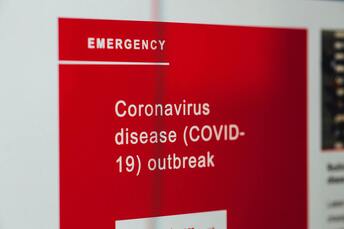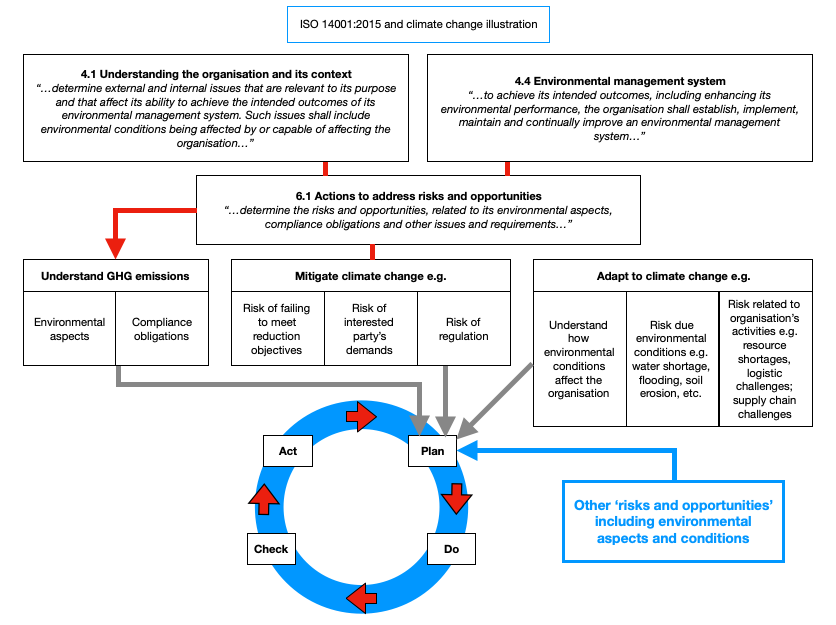 Last month we looked at ISO 14001 and the way it looks at environmental ‘aspects’ - products and services that interact with the environment - and ‘impacts’, namely their impact on the environment. Another important part of the standard is how you undertake measures for ‘emergency preparedness and response’. So why is this part of an environmental standard? Basically, if there is an emergency situation where a negative environmental impact takes place, the company needs to have plans in place to deal with this situation to avoid or minimise environmental damage. Despite an organisation’s best efforts, the possibility of accidents and other emergency situations still exist. Effective planning and preparation can reduce injuries, protect employees and neighbours, reduce losses and minimise any production downtime. The standard requires that three components are addressed by the organisation:
So, in essence, an effective emergency preparedness and response programme should include provisions for assessing the potential for accidents and emergencies, preventing incidents and their associated environmental impacts, plans and procedures for responding to incidents, periodic testing of emergency plans and procedures and mitigating impacts associated with these incidents. In order to decide which situations to anticipate, it is best to look to the environmental aspects that we would have identified in last month’s exercise. After deciding what potential emergency situations you have, including potential accidents that could impact the environment, you need to decide how you will respond to them. The response should be comparable to how significant the situation could be. Plans for a large spill of a potentially harmful chemical (such as dumping a barrel of acid) may entail having supplies on hand that will allow you to contain and clean the spill – including having breathing apparatuses, protective clothing and a team of skilled and trained individuals who can safely remove the spill with minimal environmental impact. Conversely, plans for a small spill of a mostly harmless chemical (such as a very small bottle of alcohol) may be addressed with less detail and fewer safety concerns. After deciding how to respond, this response needs to be documented in such a way that it can be used and understood. This again does not need to be a documented procedure, but needs to be in such a format that those in the organisation who need it can use it consistently. The procedures need to be reviewed periodically, and revised when necessary to ensure that you have a plan that will work consistently. Lastly, the standard requires that these plans be used when an actual emergency occurs, which is of course the point of having them. After an actual incident, it is also an important time to review the procedure for any errors or improvements that may be needed. Depending on the significance of the impacts, it is also required to test out the procedures where you can (such as having a pretend spill that you respond to as if it were a real spill). Consistent with your organisation’s focus on continual improvement, it is a good idea to review emergency response performance after an incident has occurred. This review can help determine if more training is needed or if emergency plans and procedures should be revised. If you would like to look at how to implement an ISO 14001 environmental management system, then simply contact us. Or, if you want to see what's involved in more detail, then get a completely free, no obligation, totally tailored ISO Gap Analysis for your business (only available to UK businesses).
0 Comments
 Last month we looked at ISO 14001 - how it has become the de facto standard for designing and implementing an environmental management system, how it works, and a bit about its history. This week we look at two key concepts in the standard which you’ll need to get to grips with in order to implement it properly. The first is ‘Environmental Aspects and Impacts’, and the other is ‘Compliance’. Environmental Aspects and Impacts An organisation’s activities, products and services that interact with the environment are referred to as ‘aspects’, which may have a negative or positive impact on the environment. Typically, aspects might include emissions to air, discharges to water and waste, which in turn may generate environmental and health impacts such as global warming, water pollution or contaminated land. Some activities, such as those of an office-based service, will have relatively minor environmental impacts, such as energy usage and emissions linked to air conditioning, whereas in some heavy industrial companies aspects such as processes that cause emissions to air and discharges to water may have significant environmental impacts. Once you’ve identified an aspect, you then need to judge its impact on the environment. Is it major or minor? If it’s major, how can it be reduced? Can it be managed better? Do you have to do it at all, or is there another way? Managing environmental aspects and impacts is arguably the most important component of an EMS, and your job is to determine which ones apply to you and their relative significance in terms of risks to the environment and then look at the controls you can put in place to minimise these as much as possible. These will usually sit in a register of significant aspects and impacts for you to monitor and update. Compliance obligations and evaluation of compliance ISO 14001:2015 has two main requirements when it comes to compliance: Identify and have access to applicable compliance obligations This is the important first step of making sure that you know all of the legal requirements related to the environmental aspects that are applicable to your company. Think about any chemicals you use - how do they relate to Control of Substances Hazardous to Health 2002 (COSHH)? Do you use cleaning products, fuel company vehicles, use paints or glues? How do you dispose of electrical equipment? Is it in line with the Waste Electrical and Electronic Equipment (WEEE) Regulations 2013? Remember that these can originate at a local, regional, national, or even international level depending on the activities of your company. If you don’t know that a specific item of legislation exists, you will very likely not meet the requirements of the legislation. Determine how these obligations apply to your organisation Equally as important as knowing that a law exists that could be applicable to your environmental aspects is knowing if it actually applies to your situation and, if so, what obligations it places upon you. Whilst there is no formal requirement to have a legal register as such, the standard requires that documented information regarding compliance obligations is maintained. So, once you have determined your compliance obligations, now you must evaluate your compliance. Here you must plan and implement a process to evaluate if you meet the environmental, legal and other requirements that are applicable to your business. In our COSHH example above, if you answered ‘yes’ to any of those things listed the chances are you’ll need to perform a ‘COSHH assessment’. This would be how you would demonstrate compliance. Your compliance evaluation process needs to include:
These are two important concepts in ISO 14001, and next week we’ll be looking at another important part of the standard, namely how you undertake measures for emergency preparedness and response. If you would like to look at how to implement an ISO 14001 environmental management system, then simply contact us. Or, if you want to see what's involved in more detail, then get a completely free, no obligation, totally tailored ISO Gap Analysis for your business (only available to UK businesses).  ISO 14001 has become the de facto standard for designing and implementing an environmental management system. An environmental management system - often called an EMS - needs to be tailored to your particular company, because only your company will have the exact legal requirements and environmental interactions that match your specific business processes. However, the ISO 14001 requirements provide a framework and guidelines for creating your environmental management system so that you do not miss important elements needed for an EMS to be successful. A brief history of ISO 14001 In March 1992, the British Standards Institute (BSI) published the world’s first environmental management systems standard, BS 7750, as part of a response to growing concerns about protecting the environment. Prior to this, environmental management had been part of larger systems such as ‘Responsible Care’ (a voluntary initiative developed autonomously by the chemicals industry in Canada). BS 7750 supplied the template for the development of the ISO 14000 series in 1996. Prior to the development of the ISO 14000 series, organisations voluntarily constructed their own Environmental Management Systems (EMS), but this made comparisons of environmental effects between companies difficult: therefore, the universal ISO 14000 series was developed. An EMS is defined by ISO as: “part of the overall management system, that includes organizational structure, planning activities, responsibilities, practices, procedures, processes, and resources for developing, implementing, achieving, and maintaining the environmental policy.” Why you should use ISO 14001:2015 as your Environmental Management System ISO 14001 is an EMS which provides a structure for measuring and improving your environmental impact. The areas you’ll need to look at would be:
ISO 14001 enables companies to put in place an effective environmental management system which is designed to address the balance between a company’s environmental impacts while maintaining profitability. Common requirements between ISO 9001 and ISO 14001 When you implement an ISO 14001 management system you’ll find that the requirements are very common between the ISO 14001 and ISO 9001 standards. Both require you to:
However, ISO 14001 has three distinct requirements in addition to the above:
We’ll go into more detail about these over the coming months, so if you’re considering getting ISO 14001 then stay tuned! If you would like to look at how to implement an ISO 14001 environmental management system, then simply contact us. Or, if you want to see what's involved in more detail, then get a completely free, no obligation, totally tailored ISO Gap Analysis for your business (only available to UK businesses).  The world has only until 2030 to stem catastrophic climate change - but can companies be part of the solution? And, if so, how? A report published by the UN Intergovernmental Panel on Climate Change said that “rapid, far-reaching and unprecedented changes in all aspects of society” are needed to avoid disastrous levels of global warming. Whilst often seen as culprits, businesses can actually set a positive example. What is ISO 14001:2015? ISO 14001 enables companies to put in place an effective environmental management system, and is designed to address the balance between a company’s environmental impacts while maintaining profitability. Environmental issues are growing in prominence; energy efficiency, environmental compliance, environmental impact, and carbon footprint are widely discussed. In implementing an environmental management system, companies can effectively control these issues, and ensure that they are fully compliant with environmental legislation. They also join in the fight against climate change. Being ISO 14001 certified proves to stakeholders, customers, suppliers etc. that you are environmentally credible. So what’s the link between ISO 14001 and climate change? One of the major challenges that face us all is that of mitigating and adapting to climate change. Internationally, work has progressed from the formation of United Nations Convention on Climate Change (UNFCCC) to the Paris Agreement which came into force on 4 November 2016. Under the Paris Agreement countries agree to hold the global temperature increase due to increase in greenhouse gas (GHG) emissions, to below 2 °C, aiming at 1.5 °C. This commitment is realised through a commitment at national level to reduce national GHG emissions. Additionally, countries agreed to support action to adapt to the consequences of climate change. For users of ISO 14001 the question is 'How does ISO 14001 help organisation to mitigate and adapt to climate change?' The diagram below shows the link between key clauses in ISO 14001:2015 and climate change mitigation and adaption. It shows that users of ISO 14001 CAN address climate change challenges through their management system: ISO 14001 deals with the need to adapt to any change in environmental conditions and hence include matters such as the need to adapt to other environmental consequences which are not due to climate change, for example loss of ecosystem services and biodiversity. Additionally ISO 14007 and ISO 14008 help companies provide a ‘value’ and ‘determine the costs’ for the GHG they emit and to ‘determine the cost benefit’ in their company for any action they take to adapt to climate change. So UN Sustainable Development Goals - can ISO standards help? Yes! Eight out 17 UN SDGs directly link to the focus of ISO 14001, such as those related to clean water and sanitation; affordable and clean energy; decent work and economic growth; industry, innovation and infrastructure; responsible consumption and production; climate action; life below water; and life on land. The UN SDGs cover both mitigation of environmental impacts and adaptation to changes in the environment – both topics are covered by ISO 14001. Four out of 17 UN SDGs – while relating to human and social issues – are areas where ISO 14001 by, among others, reducing harmful emissions reduces the impact on human health as exemplified by the goal on zero hunger and no poverty. Which UN SDGs and targets may be considered by a company using ISO 14001 will depend on many and diverse factors such as what the organisation does, its resources and its overall business aims. How does ISO 14001:2015 support achievement of UN SDGs? ISO 14001 in relation to environmental matters cover issues such as: Protecting the environment commit to proactive initiatives to protect the environment from harm and degradation; protect the environment can include prevention of pollution, sustainable resource use, climate change mitigation and adaptation, protection of biodiversity and ecosystems, etc. Environmental performance continual improvement focus on improving environmental performance Lifecycle perspective extend its control and influence to the environmental impacts associated with product use and end-of-life treatment or disposal Strategic Environmental Management increased focus on environmental management within your company’s strategic planning processes and understanding your context focus:
If you run a business and care about climate change and - more importantly - want to do something about it, then getting and effectively operating ISO 14001 is definitely for you! If you would like to look at how to implement an ISO 9001 quality management system, then simply contact us. Or, if you want to see what's involved in more detail, then get a completely free, no obligation, totally tailored ISO Gap Analysis for your business (only available to UK businesses).  Millions of people around the world have lost their jobs amid the current Covid-19 crisis - it is a crisis within a crisis. The long-term economic impact is yet unknown but will surely be deep. What is not in doubt is that the economic strain on companies of all sizes across the UK and the rest of the world will be here for the foreseeable future. Manufacturers have closed plants, stores are shut, and consumer demand has collapsed in many sectors. Research by the Institute for Social and Economic Research at the University of Essex has found that more than 6.5 million jobs could be lost due to the economic fallout from the UK’s coronavirus lockdown, about a quarter of the UK’s total jobs. A simply staggering number of companies have plunged into administration, from stalwart high street brands to major travel agents, as well as a whole raft of businesses in sectors such as construction. The true toll is only just beginning to be understood. So it’s no surprise that companies which are still managing to keep their heads above water will be starting to look at deep cost-cutting measures in the short- and medium-term. With profit centres being hit like never before, cost centres such as ISO compliance will undoubtedly have fewer resources until the economy turns around. What does this mean for the ISO compliance functions of companies that are struggling? In practical terms, they will have to make risk-based decisions about how to allocate the limited resources that they have. And one important thing to think about is how you can use the expertise of companies such as The Ideas Distillery to outsource your compliance tasks cost-effectively with little overhead. Certification Bodies have recognised, for the moment at least, that the world has changed significantly. Just about all have turned to ‘remote auditing’ as a way to still service clients while still respecting the lockdown. There has also been the option of postponing for up to six months in many circumstances, although this option is now starting to wind down. Any company’s priority will simply be to put themselves in a position to survive the crisis. So when dealing with budget constraints and limited compliance resources, flexibility and creativity will be key. For our part, when we are helping businesses in these scenarios, we always assess risk and conduct a review with the aim of identifying core ISO compliance requirements. This often entails a historic review of internal procedures and controls to identify past activities or other problems to determine where the biggest risks reside. External industry risks such as enforcement actions brought against competitors should be considered as well, along with identifying low-risk areas where there have been few incidents or problems. But more significantly, we help companies to determine if new, immediate significant risks have arisen due to the pandemic. Another emerging risk may exist in a company’s sales department, for example, perhaps due to the pressures of bringing in new business. This may be an area that leads to an increase in customer complaints as things are missed. The crisis may have caused companies to find new suppliers that have not been fully vetted due to time pressures. Likewise, the pandemic may have caused substantial risks to employee safety associated with reopening businesses. This emerging risk will likely call for the development of new policies and procedures that will require close oversight by senior management. For more information - and to see how we can help - just get in touch with us in any number of ways using on our Contact page. If you would like to look at how to implement an ISO 9001 quality management system, then simply contact us. Or, if you want to see what's involved in more detail, then get a completely free, no obligation, totally tailored ISO Gap Analysis for your business (only available to UK businesses). |
WelcomeHere you'll find the latest blog articles on all things compliance, particularly focussed on quality, environment, health & safety and information security. Get a completely free, no obligation, totally tailored ISO Gap Analysis for your business...
Categories
All
Archives
April 2024
|
|
Read about our ISO implementation services...
|
Read about our ISO maintenance services...
|

 RSS Feed
RSS Feed


